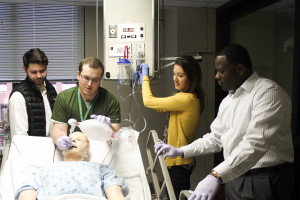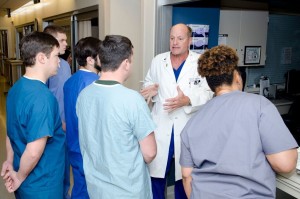By David Thill
Simulated OR allows UAB students to take a dry run at medical sales
 Eight years ago, the University of Alabama at Birmingham’s School of Business began its Medical Equipment and Supplies Distribution track – a unique opportunity for future distributor sales reps to learn skills for success. (See July 2008 Repertoire.) Since then, the program has evolved to become even more relevant to today’s medical sales industry.
Eight years ago, the University of Alabama at Birmingham’s School of Business began its Medical Equipment and Supplies Distribution track – a unique opportunity for future distributor sales reps to learn skills for success. (See July 2008 Repertoire.) Since then, the program has evolved to become even more relevant to today’s medical sales industry.
“Many companies that did not typically hire college graduates are finding that the graduates from our medical distribution program are just as effective as those with [professional sales] experience,” says Thomas E. DeCarlo, PhD, Ben S. Weil Endowed Chair in Industrial Distribution.
In 2013, UAB created a two-course sequence that pairs sales distribution students with biomedical students. In the first semester, students work to enhance and develop medical products and devices. During the second semester, they develop marketing and sales strategies for those products.
“These are real products that have been developed at UAB,” says DeCarlo, adding that eventually the school hopes to obtain patents on the products. “These courses extend our students’ expertise beyond the classroom or into getting a basic understanding of what it takes to develop and launch new products.”
Distribution Program Manager Kristen Craig adds that this course sequence allows students the opportunity to develop a solution that is “real-time,” rather than a case study or retrospective look at what a company did to solve a problem. The students get to work with actual clinicians to solve real issues, she says.
Simulated OR
 Last year, the medical distribution program formed a partnership with UAB’s Office of Interprofessional Simulation for Innovative Clinical Practice (OIPS) to offer students hands-on learning and actual marketing experience. OIPS is an enterprise-wide umbrella organization at UAB that oversees, develops, and supports interprofessional clinical simulation experiences. OIPS partners with practicing clinicians in the hospital, as well as with faculty in all schools across campus to develop interactive learning experiences, hands-on training, immersive simulations, and a variety of other educational modalities to foster an environment of safe-learning in the simulated setting.
Last year, the medical distribution program formed a partnership with UAB’s Office of Interprofessional Simulation for Innovative Clinical Practice (OIPS) to offer students hands-on learning and actual marketing experience. OIPS is an enterprise-wide umbrella organization at UAB that oversees, develops, and supports interprofessional clinical simulation experiences. OIPS partners with practicing clinicians in the hospital, as well as with faculty in all schools across campus to develop interactive learning experiences, hands-on training, immersive simulations, and a variety of other educational modalities to foster an environment of safe-learning in the simulated setting.
The goal of the new partnership is threefold, says DeCarlo. First, it provides a setting – other than the high-pressure OR or physician’s office – in which distributor reps can demonstrate new products and technologies to doctors, nurses, and other medical professionals. Second, it gives medical distribution students a chance to see “firsthand, how those presentations change based on the audience.” And third, it provides students an opportunity to set up visits to the lab by medical distributors and manufacturers. “We hope it will provide opportunities for students to build relationships with company representatives,” he says.
Dr. Marjorie White, the director of OIPS and the vice president for simulation in the UAB Health System, adds that “the partnership with the medical distribution program helps us to bridge the gap between our mission of providing state-of-the-art simulation-based learning for UAB’s healthcare providers and cutting-edge medical device companies.” Simulation labs have often been used as a place for product testing and demonstrations, and UAB’s simulation labs are no stranger to that. So this was a very organic symbiotic relationship.
Craig points out that while simulated settings have long been used to train healthcare professionals, “when you integrate [our medical distribution] students, it grounds their education in one more concrete way.
“These are the unique opportunities that make the young professionals qualified, which in turn makes companies more likely to hire them,” she says. “It is a transformation [in the] training of young professionals.”
Craig says that the simulation experience will serve as a training ground and a new line of communication between distributor reps and manufacturing reps. “It is a great synergy between the manufacturer and distributor,” she notes, as the manufacturer trains the distributor in the use of the product, and the distributor in turn demonstrates the product’s use to the doctors and other professionals.
Currently, the lab re-creates the OR and the clinical lab environment, says DeCarlo. In the future, it will be modified to depict other aspects of the typical acute-care and non-acute-care facility, from surgery and clinical work to purchasing and billing.
“Think of how unique it would be [for students] to have the opportunity to interact with purchasing agents” in a simulated setting, says Craig. By doing so, students will get to see “what it takes to get a sale through…to have that holistic perception of what they would be facing in the industry.”
In short, says DeCarlo, the medical distribution track’s partnership with OIPS provides for better training: “for better opportunities to learn by doing.”
Companies interested in learning more about partnerships with the UAB Office of Interprofessional Simulation should contact Dr. White (mlwhite@uab.edu), or Dr. DeCarlo (tdecarlo@uab.edu).
David Thill is a contributing editor for Repertoire.